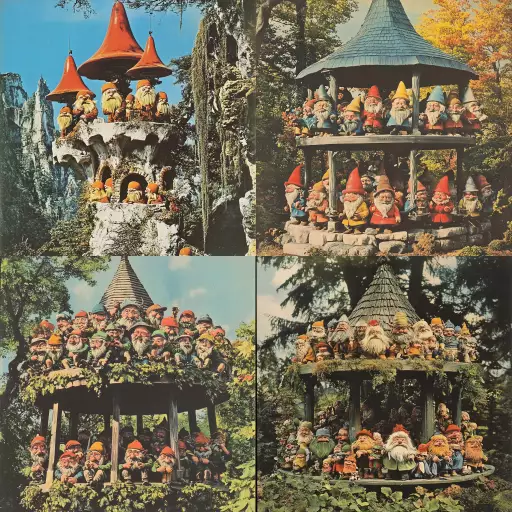Explore the Best AI Image Gallery

The Smart Canvas: How IoT is Transforming the Creative Industry
The Internet of Things (IoT) is rapidly changing our world, weaving a web of interconnected devices that collect data, automate tasks, and enhance our daily lives. This pervasive technology isnt confined to the realm of smart appliances; its also revolutionizing the creative industry, offering artists, designers, and innovators unprecedented opportunities for expression and collaboration.
Smart homes, powered by IoT, are becoming increasingly sophisticated canvases for creative exploration. From interactive installations that respond to user movements to personalized art experiences tailored to individual preferences, the boundaries between technology and creativity are blurring.
Unleashing New Creative Possibilities
IoTs impact on the creative industry is multifaceted:
- Interactive Art Installations: Imagine a sculpture that changes color based on the temperature of the room or a painting that reacts to the viewers heartbeat. IoT sensors can be integrated into art pieces, enabling them to become dynamic and responsive, engaging audiences in novel ways.
- Personalized Creative Experiences: Smart homes equipped with IoT devices can curate personalized art experiences for residents. Imagine an AI-powered system that learns your taste in music and artwork, then dynamically adjusts the lighting, sound, and even scents to create a tailored ambiance.
- Collaborative Creativity: Artists can leverage IoT to collaborate remotely on projects, sharing ideas and working together in real time regardless of location. Imagine sculptors collaborating on a digital model, designers brainstorming fashion concepts using augmented reality, or musicians composing music together through interconnected instruments.
Ethical Considerations
While the potential of IoT in the creative industry is immense, it also raises ethical considerations that need careful attention:
- Data Privacy: Smart homes collect vast amounts of data about residents activities and preferences. Its crucial to ensure this data is handled responsibly, with transparent consent mechanisms and robust security measures in place.
- Algorithmic Bias: AI algorithms used in personalized creative experiences could perpetuate existing biases if not carefully trained and monitored. Its important to strive for fairness and inclusivity in the development and deployment of these technologies.
- Accessibility: IoT-powered creative tools should be accessible to individuals with diverse abilities and backgrounds. Designing inclusive solutions is essential to ensure everyone can benefit from these advancements.
Future Trends
The intersection of IoT and creativity is constantly evolving, with exciting trends on the horizon:
- Immersive Experiences: Expect to see more immersive creative experiences powered by virtual reality (VR) and augmented reality (AR), where users can interact with digital art, design objects in 3D space, or even collaborate on projects within shared virtual environments.
- The Rise of Smart Materials: Imagine materials that change color, texture, or even shape in response to stimuli. IoT-enabled smart materials will open up new possibilities for dynamic and responsive art installations.
- Democratization of Creativity: IoT tools will empower individuals to become creators, regardless of their technical expertise. User-friendly interfaces and intuitive platforms will make it easier than ever for anyone to express themselves creatively through technology.
The smart canvas is evolving rapidly. As IoT continues to integrate with our lives, the creative industry stands on the cusp of a new era, where imagination knows no bounds and the possibilities for artistic expression are limitless.




](https://images.ai-img.art/thumbnails/150/51c93500396faff4e7fa8b42bc68033067b16b2230e3496e95c482a581ff0fe9.webp)
](https://images.ai-img.art/thumbnails/150/9d51c5e673b4f2068b7b01abc35425a06f173b76303adf9ad29ca14302c25b18.webp)






![**Representation: A dog acting as a private tutor to a child. The dog holds a ruler in its paw and stands at the blackboard to explain a dog diagram to the child. Graphic style: Line drawing, cartoon style, influenced by Franco-Belgian comics, thick black lines, simplified design, vector, black and white only, in the style of Keith Haring or the French comic strip "Alinéa". [IMPORTANT]: A single continuous line extending from one side of the image to the other, minimalist, strong outlines, line drawing, without lifting the hand, ultra-simplified, no shading, entirely white image, drawing created in the center of a sheet of paper. --ar 16:5** - <@627984126871470085> (fast)](https://images.ai-img.art/thumbnails/150/7a854648a81e51241dcca8d24dd6e3bfcf07ad1df51baf401c9b729f4cf411fa.webp)












![**Representation: A teenager smiling while thinking about a friendly dog, a comic-style thought bubble with a friendly dog inside. Graphic style: Line drawing, cartoon style, influenced by Franco-Belgian comics, thick black lines, simplified design, vector, black and white only, in the style of Keith Haring or the French comic strip "Alinéa". [IMPORTANT]: A single continuous line extending from one side of the image to the other, minimalist, strong outlines, line drawing, without lifting the hand, ultra-simplified, no shading, entirely white image, drawing created in the center of a sheet of paper. --ar 16:5** - <@627984126871470085> (fast)](https://images.ai-img.art/thumbnails/150/6fc850f638e3dee0c4b121acecad2c8419e02bdeac7f871d625f1003c1c3abe1.webp)

![**Representation: A dog acting as a private tutor to a child. The dog holds a ruler in its paw and stands at the blackboard to explain a dog diagram to the child. Graphic style: Line drawing, cartoon style, influenced by Franco-Belgian comics, thick black lines, simplified design, vector, black and white only, in the style of Keith Haring or the French comic strip "Alinéa". [IMPORTANT]: A single continuous line extending from one side of the image to the other, minimalist, strong outlines, line drawing, without lifting the hand, ultra-simplified, no shading, entirely white image, drawing created in the center of a sheet of paper. --ar 16:5** - Variations (Strong) by <@627984126871470085> (fast)](https://images.ai-img.art/thumbnails/150/f4e034998ccd869d8a061fd12017514fcd92210eb33d4222dc9b54716223f4dd.webp)



](https://images.ai-img.art/thumbnails/150/157712d76865d557120f9baf988de3d0525225295a2789c89bf2c4a5a96a03d1.webp)












